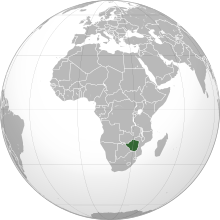Squatting in Zimbabwe

Squatting in Zimbabwe is the settlement of land or buildings without the permission of the owner.
History
Squatting on the territory that would later become
When the government purchased land from
Sometimes squatting is used as a housing tactic by workers who have recently been made unemployed, such as miners from closed down mines or agricultural workers from farms bought up by the government. In cases such as these, the authorities are more lenient and tolerate the squatters, for example at Insiza District near Bulawayo.[5]
By 2015, a housing crisis had developed and informal settlements were booming on the periphery of Harare in districts such as Amsterdam, Borrowdale, Hopley Farm, Mabvuku and Waterfalls, as well as nearby Chitungwiza.[6]
Operation Murambatsvina
In 2005, the ruling
Opposition leaders in Zimbabwe suggested that the evictions were aimed at punishing slum dwellers for not voting for ZANU-PF.[7] After three weeks of evictions, President Robert Mugabe responded that the operation was a "a vigorous clean-up campaign to restore sanity" in which around 30,000 people had been arrested.[9] The United Nations envoy Anna Tibaijuka estimated that 700,000 people had been evicted and over two million people had been affected. Mugabe's administration blocked aid efforts.[10] John Vidal wrote in The Guardian "the vilification of Mugabe is now out of control".[11] In Bulawayo, squatters returned to their demolished shacks and started rebuilding them.[10]
References
- ^ Nkiwane, Victor (1993–1994). "The problem of urban squatting in Africa countries – with a special focus on Nairobi (Kenya) and Harare (Zimbabwe)" (PDF). Zimbabwe Law Review. 11.
- .
- ISBN 978-0-520-36561-2. Archivedfrom the original on 17 March 2021. Retrieved 7 March 2021.
- .
- .
- ^ Matabvu, Debra; Agere, Harmony (11 January 2015). "Squatters: Housing shortages or lawlessness?". The Sunday Mail. Archived from the original on 8 November 2018. Retrieved 7 March 2021.
- ^ a b c "Africa rejects action on Zimbabwe". BBC News. 24 June 2005. Archived from the original on 13 February 2021. Retrieved 7 March 2021.
- ^ "Africa urged to act over Zimbabwe". BBC News. 23 June 2005. Archived from the original on 23 January 2007. Retrieved 7 March 2021.
- ^ "Mugabe defends township crackdown". BBC News. 9 June 2005. Archived from the original on 23 December 2006. Retrieved 7 March 2021.
- ^ a b "Zimbabwe: Mugabe's clean-up victims flock back to squatter camps – Zimbabwe". Zim Online. 21 September 2005. Archived from the original on 17 March 2021. Retrieved 7 March 2021.
- ^ Vidal, John (1 July 2005). "Zimbabwe is being hypocritically vilified by the west". The Guardian. Archived from the original on 8 March 2021. Retrieved 7 March 2021.
Further reading
- Hughes, David McDermott (December 1999). "Refugees and Squatters: Immigration and the Politics of Territory on the Zimbabwe-Mozambique Border". Journal of Southern African Studies. 25 (4): 533–552. .


